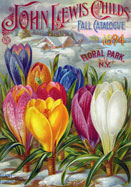|
Order these fall-planted bulbs NOW for delivery in October. |
||

WHY GROW CROCUS? There’s always room for crocus! You can squeeze hundreds into empty scraps of space. They bloom when you’re hungriest for flowers. They multiply quickly. And their thin, wispy foliage disappears quickly. CROCUS HISTORY — Native from Spain to Afghanistan, crocus have been cherished in gardens since at least the 1500s. Learn more. TIPS FOR SUCCESS — Though they love sun, crocus can thrive in light shade under trees, shrubs, and perennials, and even in the lawn sometimes. Learn more. |
||
|
||
|
||
|
||
|
||
|
||
|
||
|
||
|
||
|
||
|
||
|
||
|
WHY GROW CROCUS? There’s always room for crocus! You can squeeze hundreds of them into empty scraps of space. They bloom when you’re the hungriest for flowers. They multiply quickly. And their thin, wispy foliage disappears quickly. HISTORY — Native from Spain to Afghanistan, crocus have been cherished in gardens since the 1500s. Victorian gardeners planted entire carpet-beds of them. Species or snow crocus, though most popular today, were rare in gardens before 1940. CROCUS ARCHIVES — For customer tips and raves, the stories behind the bulbs, links and books, history, news, and more, see our Crocus Newsletter Archives. CROCUS IN THE LAWN — Though it’s never the first place we recommend planting crocus, in the right conditions some varieties can do well in lawns. For helpful advice from our customers (and the Missouri Botanical Garden), see our “Crocus in the Lawn” page. PLANTING & CARE — For best growth and bloom, plant crocus as soon as the soil cools in the fall, giving them as long as possible to establish roots before soil freezes completely. If absolutely necessary, store briefly in open bags in a cool, dry spot. Choose a site with well-drained soil (avoid or improve clay soil) in full sun to very light shade. Crocus often do well in the dappled shade of deciduous trees and shrubs or around the base of perennials such as peonies because they can complete most of their life cycle before these plants leaf out completely and limit their sun. Though they prefer neutral to slightly alkaline soil, they are very adaptable. For SNOW OR SPECIES CROCUS, plant with the base 2-3 inches deep and 2-3 inches apart from center to center (or closer for a lush look). For TRADITIONAL CROCUS, plant with the base 3-4 inches deep and 3-4 inches apart from center to center (or closer for a lush look). Plant with the growing tip up. Scratch a little bulb fertilizer into the surface soil (slow-release 10-10-10 is ideal). Water and make sure the soil stays reasonably moist from fall through spring. During the summer, however, crocus do better if the soil is dry. If animals dig your newly-planted bulbs, try covering them for a couple of weeks with chicken wire, plastic-mesh netting, old screens, etc. An airy mulch of straw, etc., can be helpful the first winter, but remove it in earliest spring. Do NOT apply a thick mulch of shredded bark, etc. Crocus are too small to push their way up through a thick, heavy mulch. After bloom, allow the foliage to yellow completely (to feed the bulbs for increase and future bloom) before removing. |

|
FALL
|
· |
SPRING
|
· |
SUMMER
|
· |
LEARN MORE
|
· |
ORDERING
|

|



























